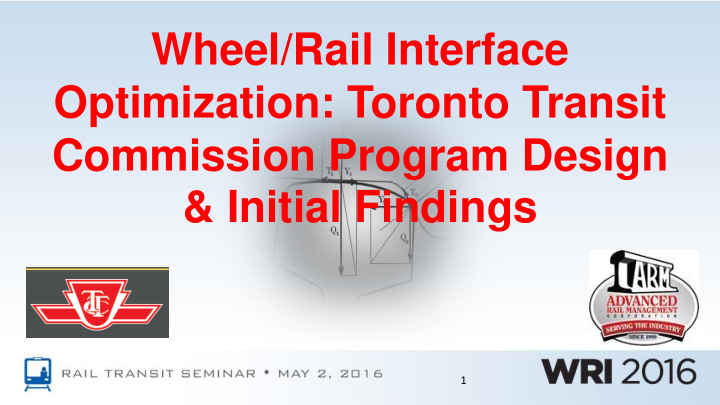



Wheel/Rail Interface Optimization: Toronto Transit Commission Program Design & Initial Findings 1
TTC WRI OPTIMIZATION Overview Project Background Project Objectives Project Approach Project Work Completed Project Interim Results 2
Project Background TTC WRI OPTIMIZATION 3
TTC WRI OPTIMIZATION Project Background TTC Recognized several opportunities for improvements on its subway and LIM systems Wheel life being dominated by the slid flats Non-optimal lubrication Rail surface damage on Subway and SRT (Lim System) RCF, Corrugation, Rail Wear Wheel/Rail Noise 4
TTC WRI OPTIMIZATION Project Background Treat the issues as being related instead of treating each separately Attack project as a team with complete participation and active involvement of all departments 5
Project Objectives TTC WRI OPTIMIZATION 6
TTC WRI OPTIMIZATION • Project Objectives Reduce System Noise Improve Wheel Life Minimize and Control Rail Surface Damage Improve System Lubrication Network 7
Project Approach TTC WRI OPTIMIZATION 8
TTC WRI OPTIMIZATION Metallurgy Project Objectives: Grinding & • ARM developed a Truing project based around a systems Friction approach with the Management Wheel/Rail Interface at its core Vehicle & Wheel & Rail Track Design Profile Design 9
TTC WRI OPTIMIZATION • Project Approach: Inspection of Existing Conditions Education of Staff Measure acoustics across system Assess compatibilities of Wheel & Rail Profiles Evaluate current state of Friction Management Develop a Maintenance & Monitoring Plan 10
TTC WRI OPTIMIZATION System Assessment/Maintenance & Monitoring Wheel/Rail Profile Compatibility ARM System Noise Project Team Friction Mgt Don Eadie 11
Work Completed TTC WRI OPTIMIZATION 12
TTC WRI OPTIMIZATION • Vehicle Inspection Wheel Condition Wheel Truing Axle Alignment 13
TTC WRI OPTIMIZATION • Track Inspection RCF Restraining Rail Wear Corrugations 14
TTC WRI OPTIMIZATION • Lubrication Review Grease Application Reservoir Condition Flange Lubricator Efficacy 15
TTC WRI OPTIMIZATION • Education – WRI Principles Course Insert Photo(s) – 4 One Day Classes From Short – Nearly 100 Attendees Course 16
TTC WRI OPTIMIZATION Acoustic Radar Speed Measurement Setup MIC Laptop Power/DAQ 17
TTC WRI OPTIMIZATION Example Acoustic Measurements Awt, dBA TCI, decibels Speed, kph 770 Hz 23 mm=0.9” Corrugations Track joints (every 39’) 0 3K Distance from Platform, ft 18
TTC WRI OPTIMIZATION Reporting Based on Acoustic Measurements Including Grinding Priority Report 19
TTC WRI OPTIMIZATION • Wheel/Rail Profile Analysis 20
TTC WRI OPTIMIZATION • Wheel/Rail Profile Analysis 21
Project Interim Results TTC WRI OPTIMIZATION 22
TTC WRI OPTIMIZATION • Wayside Lubrication Opportunities for Improvement – Large reservoir tanks where the grease may sit more than a year – Lubricator placement in curves – Older equipment that lacks accuracy to control grease application compared to current technology 23
TTC WRI OPTIMIZATION • Recommended Gage Face Lubricator Actions – Standardization of equipment – Proper placement of lubricator in curves 24
TTC WRI OPTIMIZATION • Vehicle Mounted Lubricator Opportunities for Improvement – Current mounting locations provide insufficient wheel flange coverage Solid Stick Applicator 25
TTC WRI OPTIMIZATION • Recommended Train Mounted Friction Management – Solid Sticks Placed Optimally Throughout Trainset Solid Stick Applicator 26
TTC WRI OPTIMIZATION • Top of Rail Friction Control – Reduce rate of RCF occurrence and growth – Reduce rate of corrugation occurrence and growth Positive Friction Curve Negative Friction Curve 27
TTC WRI OPTIMIZATION • Acknowledgements – Toronto Transit Commission – National Research Council Canada – ATS Consulting – Don Eadie 28
Recommend
More recommend